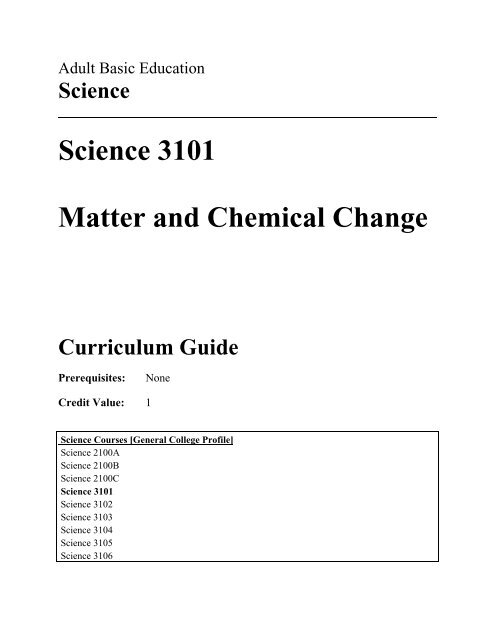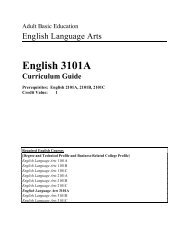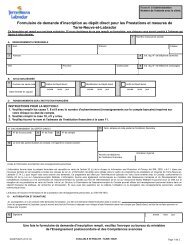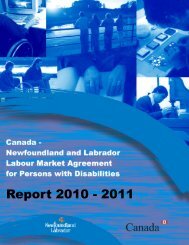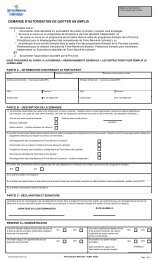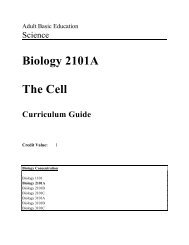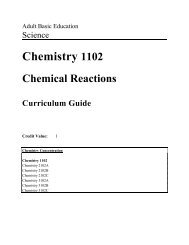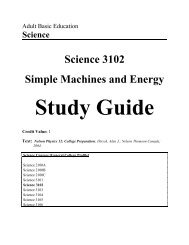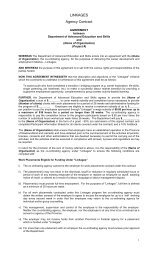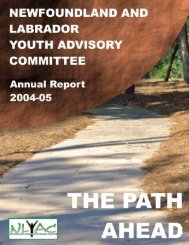Science 3101 Curriculum Guide 2005-06
Science 3101 Curriculum Guide 2005-06
Science 3101 Curriculum Guide 2005-06
Create successful ePaper yourself
Turn your PDF publications into a flip-book with our unique Google optimized e-Paper software.
Adult Basic Education<strong>Science</strong><strong>Science</strong> <strong>3101</strong>Matter and Chemical Change<strong>Curriculum</strong> <strong>Guide</strong>Prerequisites:NoneCredit Value: 1<strong>Science</strong> Courses [General College Profile]<strong>Science</strong> 2100A<strong>Science</strong> 2100B<strong>Science</strong> 2100C<strong>Science</strong> <strong>3101</strong><strong>Science</strong> 3102<strong>Science</strong> 3103<strong>Science</strong> 3104<strong>Science</strong> 3105<strong>Science</strong> 31<strong>06</strong>
Table of ContentsTo the Instructor...............................................................vIntroduction to <strong>Science</strong> <strong>3101</strong> ..............................................v<strong>Curriculum</strong> <strong>Guide</strong> ...................................................... viStudy <strong>Guide</strong>s .......................................................... viResources ............................................................ viiRecommended Evaluation .............................................. viiiUnit 1 - Matter ........................................................... Page 2Unit 2 - Elements and Compounds ........................................... Page 4Unit 3 - Mixtures ......................................................... Page 6Unit 4 - Chemical Reactions ............................................... Page 10
To the InstructorI. Introduction to <strong>Science</strong> <strong>3101</strong><strong>Science</strong> <strong>3101</strong>, Matter and Chemical Change, introduces students to chemicals and chemicalreactions and the role that they play in daily life.The course begins with a discussion of ways that chemicals are useful and how to use themsafely. Students are introduced to two chemical information safety systems. They learn aboutstates and properties of matter and how to tell the difference between a pure substance and amixture.In Unit 2, students investigate pure substances, elements and compounds. They learn their wayaround the periodic table and become familiar with names and formulas for some commonelements and simple compounds.In Unit 3, students investigate mixtures. They learn the difference between solutions andmechanical mixtures. They investigate concentration and solubility and are introduced to acids,bases and the pH scale.In Unit 4, students take a closer look at some everyday chemical reactions. They investigatehow substances change during a reaction and how energy is involved in every chemical reaction.They are introduced to the use of word equations to represent chemical reactions. They finishthe course by applying the knowledge that they have gained to investigate acid deposition.Students are required to complete three Assignments in this course. However, there are manytopics included in this course that students may be interested in exploring further. They could begiven additional assignments or the opportunity to investigate topics in group work.Coordination with the English program is possible in assigning and evaluating additional work.Instructors should note that the material covered in the required assignments is not intended fortesting.Students are required to complete three Core Labs in this course. Additional laboratoryinvestigations may be added.Note:Students cannot get credit for <strong>Science</strong> <strong>3101</strong> if they have previously received credit foreither <strong>Science</strong> 12<strong>06</strong> in high school or Chemistry 1102 in ABE.<strong>Curriculum</strong> <strong>Guide</strong> v<strong>Science</strong> <strong>3101</strong>
To the InstructorII.<strong>Curriculum</strong> <strong>Guide</strong>Each new ABE <strong>Science</strong> course has a <strong>Curriculum</strong> <strong>Guide</strong> for the instructor and a Study <strong>Guide</strong> forthe student. The <strong>Curriculum</strong> <strong>Guide</strong> includes the specific curriculum outcomes for the course.Suggestions for teaching, learning, and assessment are provided to support student achievementof the outcomes. Each course is divided into units. Each unit comprises a two-page layout offour columns as illustrated in the figure below. In some cases the four-column spread continuesto the next two-page layout.<strong>Curriculum</strong> <strong>Guide</strong> Organization:The Two-Page, Four-Column SpreadUnit Number - Unit TitleUnit Number - Unit TitleOutcomesSpecificcurriculumoutcomes forthe unit.Notes for Teaching andLearningSuggested activities,elaboration of outcomes, andbackground information.Suggestions for AssessmentSuggestions for assessingstudents’ achievement ofoutcomes.ResourcesAuthorized andrecommendedresources thataddressoutcomes.III.Study <strong>Guide</strong>sThe Study <strong>Guide</strong> provides the student with the name of the text(s) required for the course andspecifies the sections and pages that the student will need to refer to in order to complete therequired work for the course. It guides the student through the course by assigning relevantreading and providing questions and/or assigning questions from the text or some other resource.Sometimes it also provides important points for students to note. (See the To the Student sectionof the Study <strong>Guide</strong> for a more detailed explanation of the use of the Study <strong>Guide</strong>s.) The Study<strong>Guide</strong>s are designed to give students some degree of independence in their work. Instructorsshould note, however, that there is much material in the <strong>Curriculum</strong> <strong>Guide</strong>s in the Notes forTeaching and Learning and Suggestions for Assessment columns that is not included in the Study<strong>Guide</strong> and instructors will need to review this information and decide how to include it.<strong>Curriculum</strong> <strong>Guide</strong> vi<strong>Science</strong> <strong>3101</strong>
To the InstructorIV.ResourcesEssential Resourcesscience.connect1; Colbourne, Fernandez, et al; McGraw-Hill Ryerson; 2002.ISBN: 0070890927 (Includes Student Multimedia CD-ROM.)science.connect.2; Colbourne, Fehres, et al; McGraw-Hill Ryerson; 2003.ISBN: 0070890943 (Includes Student Multimedia CD-ROM.)science.connect1 Teacher’s Resource, Unit C.science.connect2 Teacher’s Resource, Unit C.Laboratory Supplies and Equipment.Recommended Resourcesscience.connect1 web site:http://www.mcgrawhill.ca/school/booksites/science.connect+1/science.connect2 web site:http://www.mcgrawhill.ca/school/booksites/science.connect+2/Computer with CD-ROM and Internet connectionNote: In addition to the text, this course is designed to make use of multimedia, in the form ofCD-ROM and the Internet, to help reinforce important concepts. Disc Connects refer to the useof the CD-ROM that accompanies the text. It uses interactive methods that most students willfind interesting and useful. Internet Connects (ICTs) refer to the use of internet sites to assist inlearning about topics covered in the course. ICT Masters are provided in the Teacher’s Resourceor at the text web site to assist in identifying important information.<strong>Curriculum</strong> <strong>Guide</strong> vii<strong>Science</strong> <strong>3101</strong>
To the InstructorV. Recommended EvaluationWritten Notes 10%Labs/Assignments 20%Test(s) 20%Final Exam (entire course) 50%100%<strong>Curriculum</strong> <strong>Guide</strong> viii<strong>Science</strong> <strong>3101</strong>
Matter and Chemical Change
Unit 1 - MatterOutcomes1.1 Describe safety precautionsthat should be followed whenhandling, storing, and disposing ofsubstances at home and in thelaboratory.1.1.1 Identify hazardouschemicals used at home and atwork.1.1.2 Explain how WHMISand HHPS systems safelycommunicate information aboutsubstances.1.1.3 Recognize the potentialdangers of using chemicals.1.2 Classify various forms ofmatter based on their properties.1.2.1 Define matter.1.2.2 Describe the particletheory of matter.1.2.3 Apply the particle modelof matter to explain thephysical properties of thephases of matter.Notes for Teaching and LearningMany students will be familiar with the conceptscovered in this unit, especially if they have recentlycompleted IS2013, Matter, in Level II.. Therefore,these students should be able to move quickly throughthis unit with little difficulty.Instructors could have students do the Starting PointActivity, When Substances React, on page 5 todemonstrate how mixing chemicals may have unknownconsequences. Refer to the Teacher’s Resource forinformation about this activity.Students are introduced to WHMIS and HHPS in thisunit by completing the Assignment and the Computersections at the beginning of the Study <strong>Guide</strong>. Theyshould be aware of these and know what they are usedfor, but they do not need to memorize the symbols used.Students are directed to complete the Disc ConnectWHMIS applet as part of the assignment.Note: It is suggested that instructors have the CD-ROMinstalled on a server or on individual computers and thatthe computers the students will be using are connectedto a printer.Note: Blackline Masters (BLMs) and answers to allthe BLMs are found in the Teacher’s Resource.1.2.4 Differentiate betweenphysical and chemicalproperties of matter.1.2.5 Differentiate betweenmixtures and pure substances.<strong>Curriculum</strong> <strong>Guide</strong> Page 2<strong>Science</strong> <strong>3101</strong>
Unit 1 - MatterSuggestions for AssessmentInstructors should review all the student answers to the questionsin the Study <strong>Guide</strong> for this unit. Their written work should beassigned a mark to be used as part of the final evaluation for thecourse. (Note: An overall mark of 10% is recommended for thewritten work from the Study <strong>Guide</strong>, excluding lab reports andassignments. An overall mark of 20% is recommended for thelabs and assignments.)The assignment (including the WHMIS Symbol Table and theCertificate of Completion printed out from the computersection) should be marked and the mark obtained should be usedas a portion of the final mark for the course. Students should notbe tested on the material covered in the assignment. BLMs 1-2,1-3, and 1-4 are included in the Appendix of the Study <strong>Guide</strong> andare needed for the assignment.Students will be introduced to many new terms throughout thiscourse. Instructors could suggest that students start a vocabularylist and add to it regularly as they work through the unit. Theglossary can be used to provide definitions.BLM 1-6 could be used as review and reinforcement of physicaland chemical properties.Investigation 1-B, Classifying Matter, and/or Investigation 1-C,Melting and Boiling Points, may be completed. The Teacher’sResource provides information for both these investigations.BLM 1-10 is a good review of how to measure volume, mass,and temperature.Students may be assigned additional questions from the CheckYour Understanding at the end of each section of the text or fromthe Review at the end of the chapter.Resourcesscience.connect1,Chapter 1, pages 4 - 19.science.connect1, CD-ROM.science.connect1Teacher’s Resource, UnitA.science.connect1 website:http://www.mcgrawhill.ca/school/booksites/science.connect+1/BLM 1-2, Safety SymbolInventory.BLM 1-3, SampleWHMIS Label.BLM 1-4, Sample MSDS.BLM 1-6, Chemical andPhysical Properties.BLM 1-10, Measuring.BLM 1-14, Classificationof Matter Crossword.BLM 1-14 can be used for review and reinforcement.<strong>Curriculum</strong> <strong>Guide</strong> Page 3<strong>Science</strong> <strong>3101</strong>
Unit 2 - Elements and CompoundsOutcomes2.1 Use the periodic table toidentify trends in the properties ofelements.2.1.1 Define element.2.1.2 Identify atoms as thesmallest unit of matter.2.1.3 Use the periodic table tolocate names, symbols, andproperties of elements.2.1.4 Distinguish betweengroups and periods in theperiodic table.2.1.5 Differentiate betweenmetals, non-metals, andmetalloids on the basis ofproperties.2.2 Explore the relationshipbetween elements and compounds.2.2.1 Classify pure substancesas either elements orcompounds.Notes for Teaching and LearningStudents are required to work through the DiscConnect, Periodic Table, to learn more about howchemical elements are classified and to compare thephysical properties of metal and non-metal elements.They should be provided with a copy of ICT 2-2 tocomplete as they work on the computer. They will printout a copy of the Certificate of Completion to beincluded with their notes.Students could be asked to complete Investigation 2-B,Properties of Metals and Non-metals, to help inidentifying common properties. A sample data chartand other information is provided in the Teacher’sResource.BLM 1-9 could be copied and given to students or usedas an overhead to summarize the classification ofmatter.BLM 2-5 can be copied and given to students or used asan overhead to reinforce the information provided in theperiodic table about elements. Note that the (aq)designation is not used in this text.Students are directed in the Study <strong>Guide</strong> to complete theFind Out Activity, Interpreting Chemical Formulas, onpage 37 of the text. BLM 2-6 contains a blank chartand question blanks that can be used for this activity.2.2.2 Name and write chemicalformulas for commoncompounds.2.2.3 Demonstrate theseparation of an element from acompound in a decompositionreaction.<strong>Curriculum</strong> <strong>Guide</strong> Page 4<strong>Science</strong> <strong>3101</strong>
Unit 2 - Elements and CompoundsSuggestions for AssessmentInstructors should review all the student answers to the questionsin the Study <strong>Guide</strong> for this unit. Their written work should beassigned a mark to be used as part of the final evaluation for thecourse.Students are required to complete Core Lab #1, DecompositionReaction. BLM 2-4 should be provided to students to use as alab report. Instructors should refer to the Teacher’s Resource forinformation about the lab and for the answers to the questions.Students may be assigned additional questions from the CheckYour Understanding at the end of each section of the text or fromthe Review at the end of the chapter.BLM 2-7 can be used for review and reinforcement.Instructors may give a test at the end of Unit 2 to include materialcovered in the first 2 units. BLMs 1-15 and 2-9 can be used toprovide some questions for the test. The mark for the test wouldbe used as part of the final mark for the course.Resourcesscience.connect1, Chapter2, pages 22 - 37.science.connect1, CD-ROM.Core Lab #1:Decomposition Reaction,page 32.BLM 2-4, Conduct anInvestigation 2-CWorksheet.BLM 2-5, What’s in aFormula?BLM 2-6, InterpretingChemical Formulas.BLM 2-7, PureSubstances Crossword.BLM 1-9, Classificationof Matter Flowchart.BLM 1-15, Chapter 1Chapter Test.BLM 2-9, Chapter 2Chapter Test.<strong>Curriculum</strong> <strong>Guide</strong> Page 5<strong>Science</strong> <strong>3101</strong>
Unit 3 - MixturesOutcomes3.1 Describe solutions.3.1.1 Distinguish betweenmechanical mixtures andsolutions.3.1.2 Define operationally,solute and solvent.3.1.3 Identify the solute andsolvent in a solution.3.1.4 Distinguish betweenconcentrated and dilutesolutions.Notes for Teaching and LearningStudents may be familiar with many of the concepts inthis unit, especially if they have recently completed theLevel II course, IS2013, Matter.BLM 1-9, which was suggested for unit 2, could beused again here to reinforce classification of matter.Students could do the Find Out Activity, What Kind ofMixture?, on page 44, to help them understand thedifference between solutions and mechanical mixtures.BLM 3-1 could be used to record their observations andanswer questions.3.2 Describe solubility.3.2.1 Define operationally,solubility, and identify solubleand insoluble substances.Students are given an introduction to acids and bases inthis unit. These concepts are covered in sections 4.1and 4.2 of the text.3.2.2 Define concentration andexpress concentration in termsof mass per volume.3.2.3 Explain the effect oftemperature change onsolubility.3.3 Identify acid and basesolutions on the basis of theirproperties.3.3.1 Define operationally,acid, base and neutral.<strong>Curriculum</strong> <strong>Guide</strong> Page 6<strong>Science</strong> <strong>3101</strong>
Unit 3 - MixturesSuggestions for AssessmentInstructors should review all the student answers to the questionsin the Study <strong>Guide</strong> for this unit. Their written work should beassigned a mark to be used as part of the final evaluation for thecourse.Students are required to complete the Core Lab, What is the BestSolvent?. BLM 3-5 should be provided to students to recordtheir observations and may be used as a lab report. Instructorsshould refer to the Teacher’s Resource for information about thelab and for the answers to the questions.Students could be asked to complete the Find Out Activity,Concentrations of Consumer Products, page 45, to examine theproperties of various consumer products. BLM 3-3 can be usedto record observations and answer questions.Students are not required to complete Investigation 3-A.However, if time permits, this would be a useful activity to allowstudents to examine data to support the theory that temperatureincreases solubility. This is a good opportunity for students toget practice in drawing and interpreting line graphs. Those withexperience or an aptitude for computers could be encouraged touse a spreadsheet program to do the graph (See BLM 1-12 toassist).Resourcesscience.connect1,Chapter 3, Sections 3.1 -3.3; pages 40 - 49.science.connect1,Chapter 4, Section 4.1,page 60; Section 4.2;pages 63 - 69.Core Lab #2:What is the Best Solvent?,page 48.BLM 3-1, What Kind ofMixture?BLM 3-3, Concentrationsof Consumer Products.BLM 3-5, Conduct anInvestigation 3-BWorksheet.<strong>Curriculum</strong> <strong>Guide</strong> Page 7<strong>Science</strong> <strong>3101</strong>
Unit 3 - MixturesOutcomes3.3.2 Describe, in generalterms, the pH scale as anindicator of acidity or basicity.3.3.3 Investigate the pH ofcommon substances.Notes for Teaching and LearningStudents are required to work through the DiscConnect, Acids and Bases, where they do a laboratorysimulation that runs a series of tests on household itemsto determine which are acids and which are bases. Theyshould be provided with a copy of ICT 4-3 to completeas they work on the computer. They will print out acopy of the Certificate of Completion to be includedwith their notes.Students can have the opportunity to gain hands onexperience in identifying common household mixturesass acids and bases and determining their pH bycompleting Investigation 4-B, Acids and Bases AroundYou, pages 66 - 68. BLM 4-5 can be used to recordobservations.For hands on experience in seeing how pH andconductivity are related, students could also be asked tocomplete the activity outlined on BLM 4-4,Conductivity and pH.Students should understand that small changes in pHvalue indicate very large changes in level of acidity(i.e., pH scale is logarithmic). Therefore each decreaseof 1.0 on the pH scale means a ten-fold increase in theamount of acid present. For example, a solution withpH=3 is 10 times more acidic than one that is pH=4 and100 times more acidic than one that is pH=5.<strong>Curriculum</strong> <strong>Guide</strong> Page 8<strong>Science</strong> <strong>3101</strong>
Unit 3 - MixturesSuggestions for AssessmentIf students were not tested at the end of the second unit, theyshould be given a test at the end of Unit 3 to cover the first 3units of the course. BLM 4-9, could be used to provide some testquestions. (Be careful to choose only items that relate to theoutcomes for this unit.)Resourcesscience.connect1, CD-ROM.BLM 4-5, Conduct anInvestigation 4-BWorksheet.BLM 4-9, Chapter 4Chapter Test.ICT 4-3, Defining Acidsand Bases.BLM 4-4, Conductivityand pH.<strong>Curriculum</strong> <strong>Guide</strong> Page 9<strong>Science</strong> <strong>3101</strong>
Unit 4 - Chemical ReactionsOutcomes4.1 Explore the usefulness ofchemical reactions.4.1.1 Define chemical reaction.4.1.2 Describe ways thatchemical reactions are useful.4.2 Investigate the evidence ofchemical change.4.2.1 Test for the presence ofcommon gases produced bychemical reactions. Include:carbon dioxide, hydrogen andoxygen.4.2.2 Identify evidence forchemical change associatedwith various reactions.Notes for Teaching and LearningNote that students will use science.connect2 for thisfinal unit of the course. Instructors should note thatonly some sections of Chapters 2, 3, and 4 are coveredin this unit.There are many demonstrations that instructors couldcarry out to show examples of chemical reactions.Refer to the Teacher’s Resource for suggestions.You might start this unit by doing the Starting PointActivity, Flame Tests, on page 41, to capture students’attention and get them interested in learning more aboutchemical reactions. Refer to the Teacher’s Resource formore information on this activity.In setting up Investigation 2-B, instructors may wish,depending on availability of materials, to alter orreplace some of the stations suggested in the text.4.2.3 Examine reactions forevidence of chemical change.4.3 Describe examples ofcommon reactions.4.3.1 Explain the termsreactants and products.4.3.2 Describe the reactantsand products of commonchemical reactions. Include:combustion and neutralization.<strong>Curriculum</strong> <strong>Guide</strong> Page 10<strong>Science</strong> <strong>3101</strong>
Unit 4 - Chemical ReactionsSuggestions for AssessmentStudents are required to complete Core Lab #3, IdentifyingCommon Gases, to investigate tests for the presence of CO 2 , H 2and O 2 produced by chemical reactions. BLM 2-2 should beprovided to students to record their observations and may be usedas a lab report.Students are also required to complete Core Lab #4,Investigating Chemical Reactions, to investigate evidence ofchemical change. BLM 2-6 should be provided to students torecord their observations and may be used as a lab report.Instructors should refer to the Teacher’s Resource forinformation about the labs and for the answers to the questions.BLM 2-3 could be used to review the chemical reactions coveredin Section 2.1 of the text.BLM 2-4 could be completed by students to ensure that theyunderstand combustion and neutralization.BLM 2-5 could be used to reinforce students’ understanding ofword equations.BLM 2-7 could be used after the lab for reinforcement of theprinciples learned in the investigation.Resourcesscience.connect2,Chapter 2, pages 22 - 37.science.connect2, CD-ROM.science.connect2Teacher’s Resource, UnitA.Core Lab #3:Identifying CommonGases, page 26 .BLM 2-2, IdentifyingCommon Gases.BLM 2-3, Match theTerms.BLM 2-4, Combustionand Neutralization.BLM 2-5, WordEquations.Core Lab #4:Investigating ChemicalReactions, pages 32 - 33.BLM 2-6, InvestigatingChemical Reactions.BLM 2-7, Evidence andTypes of ChemicalReactions.<strong>Curriculum</strong> <strong>Guide</strong> Page 11<strong>Science</strong> <strong>3101</strong>
Unit 4 - Chemical ReactionsOutcomes4.4 Recognize that energy isabsorbed or released by chemicalreactions.4.4.1 Define, operationally,exothermic and endothermicreactions.4.4.2 Identify reactions aseither exothermic andendothermic.4.5 Investigate and describe aciddeposition and its effects on theenvironment.Notes for Teaching and LearningReview with students their observations fromInvestigation 2-B and classify each reaction as eitherexothermic or endothermic.Outcome 4.5 is covered by completion of theassignment outlined in the Study <strong>Guide</strong>. Theassignment asks students to work through the DiscConnect, Acid Deposition. Each student is required topass in the Summary and the Certificate ofCompletion printed out from the computer with his/hername on it. The assignment should be marked and themark obtained should be used as a portion of the finalmark for the course. Students should not be tested onthe material covered in the assignment<strong>Curriculum</strong> <strong>Guide</strong> Page 12<strong>Science</strong> <strong>3101</strong>
Unit 4 - Chemical ReactionsSuggestions for AssessmentBLM 2-12 could be used to assess students’ understanding ofendothermic and exothermic reactions.BLM 3-5 could be used for additional practice of using wordequations.A final exam that covers the entire course (excluding the materialcovered by assignments) should be given and the mark used as atleast 50% of the final mark for the course.ResourcesBLM 2-12, Endothermicand ExothermicReactions.BLM 3-5, WordEquations.BLM 2-14, Chapter 2Chapter Test.BLM 2-14 might be used to supply some questions for Unit 4.<strong>Curriculum</strong> <strong>Guide</strong> Page 13<strong>Science</strong> <strong>3101</strong>


